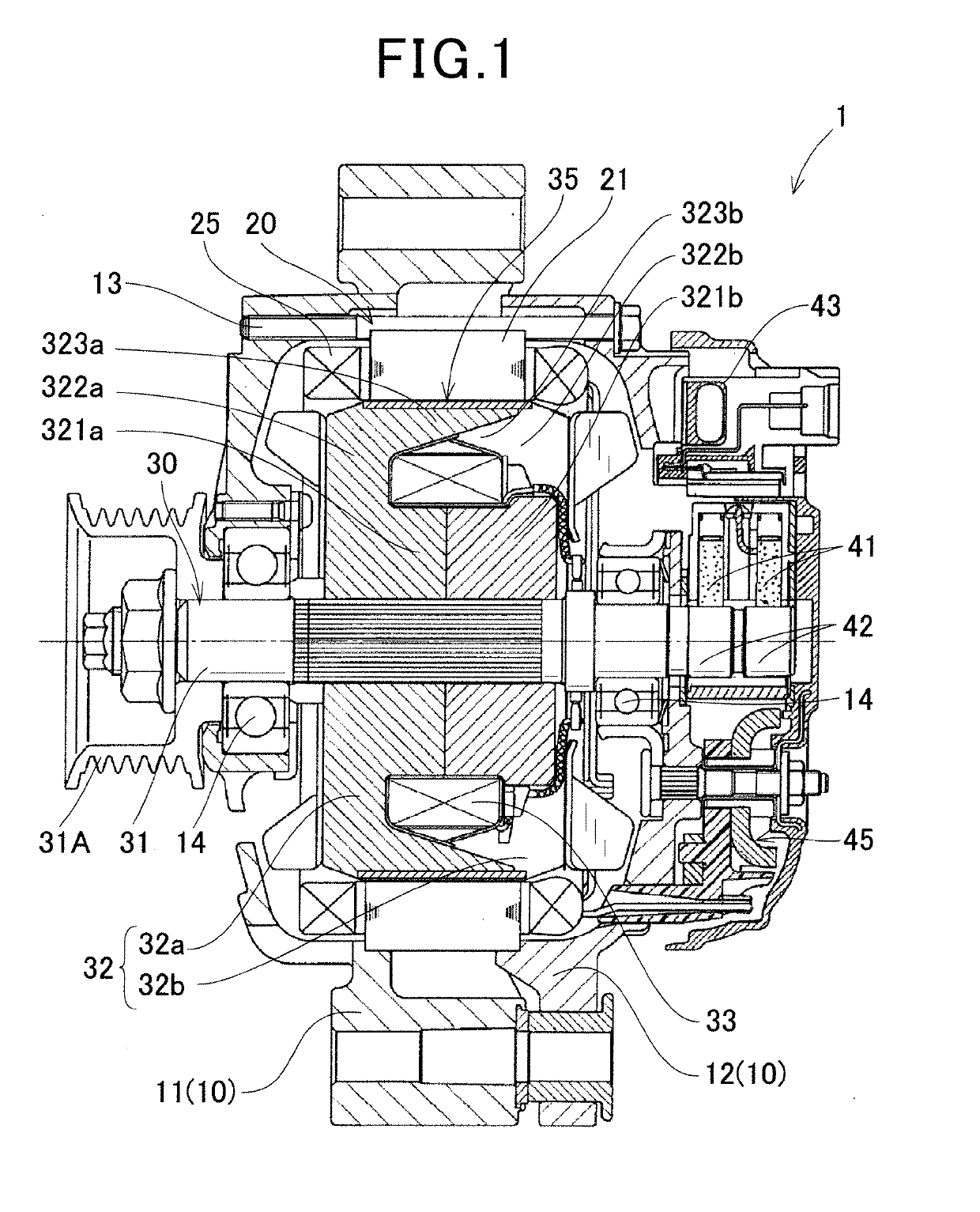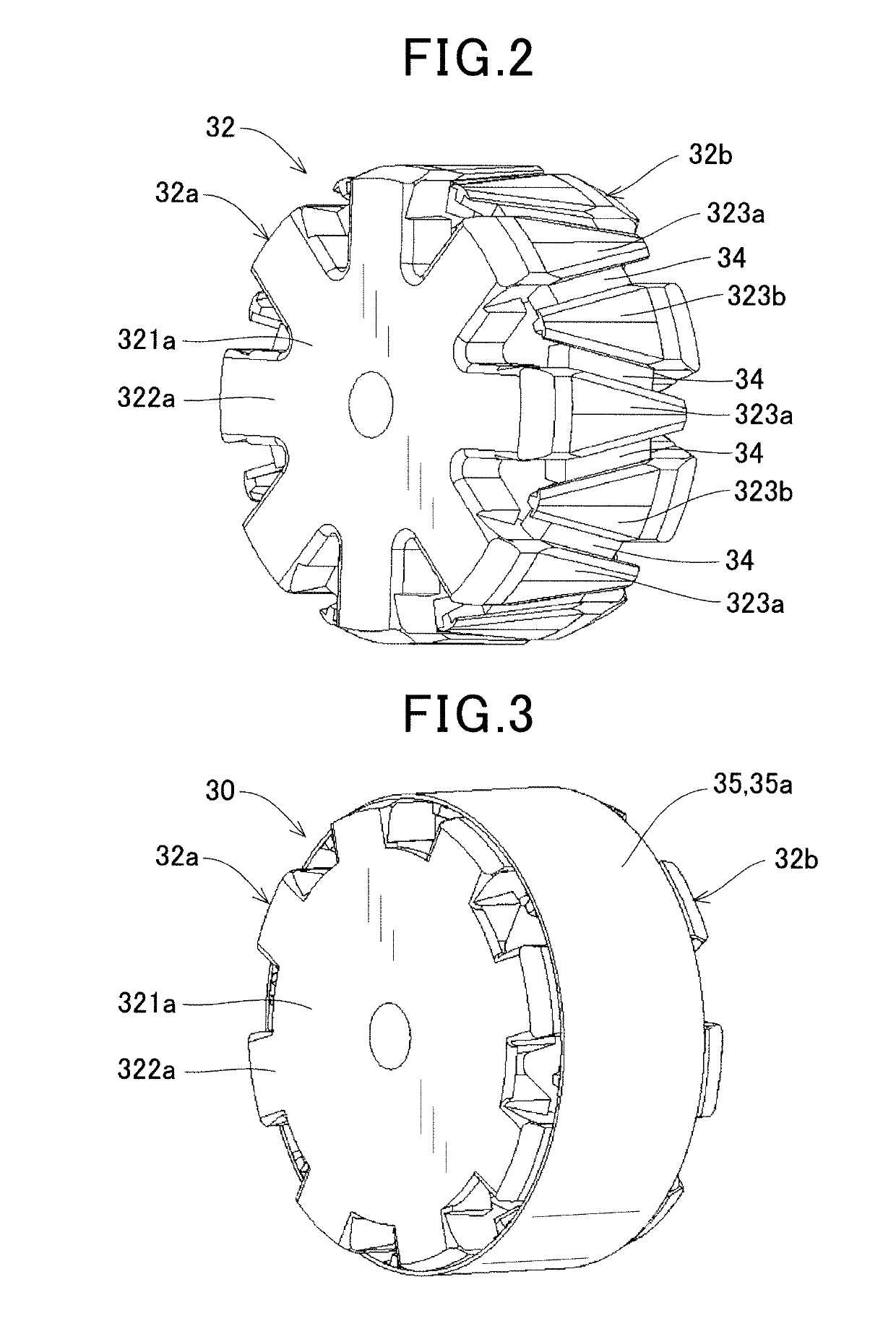Rotating electric machine
a technology of rotating electric machines and rotating shafts, which is applied in the direction of dynamo-electric machines, electrical apparatus, magnetic circuits, etc., can solve the problems of reducing the capacity of magnetic flux generation, reducing the amount of output, and reducing the optimal dimensions of magnetic circuits, so as to suppress claw-shaped magnetic pole portions, and reduce the capability of short circuit portions
- Summary
- Abstract
- Description
- Claims
- Application Information
AI Technical Summary
Benefits of technology
Problems solved by technology
Method used
Image
Examples
first embodiment
[0049]The rotating electric machine according to the first embodiment will be described with reference to FIGS. 1 to 11, 19, and 20. The rotating electric machine according to the first embodiment is a vehicle alternator mounted on a vehicle and used as a generator.
[0050]As shown in FIG. 1, a vehicle alternator 1 of the first embodiment includes a housing 10, a stator 20, a rotor 30, a field winding power supply device, a rectifier 45, and the like. The housing 10 includes a front housing 11 having a cylindrical shape with a closed-bottom and a rear housing 12, each having an open end. The front housing 11 and the rear housing 12 are fastened by bolts 13, with the open portions joined to each other.
[0051]The stator 20 includes an annular stator core 21 having a plurality of slots 22 and a plurality of teeth 23 shown in FIGS. 19 and 20 arranged in the circumferential direction, and armature windings 25 formed of three-phase windings wound in the slots 22 of the stator core 21. The pl...
first modification
[First Modification]
[0075]As shown in FIG. 10, the first modification differs from the first embodiment in the structure of the magnetic flux short circuit member 36. The magnetic flux short circuit member 36 of the first modification is also formed of a soft magnetic material in a hollow cylindrical shape with a constant wall thickness, but differs from the magnetic flux short circuit member 35 of the first embodiment in that a plurality of window portions 36b are formed in areas radially facing the permanent magnet 34 disposed between the claw-shaped magnetic pole portions 323 adjacent in the circumferential direction of the field core 32. The window portions 36b extend in directions inclined from the axial direction along the circumferential side surface of the claw-shaped magnetic pole portions 323, and are circumferentially arranged in alternately reversed directions.
[0076]The magnetic flux short circuit member 36 is fitted and secured to the outer surface of the field core 32 ...
second modification
[Second Modification]
[0077]As shown in FIG. 11, the magnetic flux short circuit members 37 of a second modification correspond to the two short circuit portions 36a at both axial ends of the magnetic flux short circuit member 36 of the first modification. That is, the magnetic flux short circuit members 37 are formed of two ring-shaped members arranged at both axial ends of the field core 32. As with the short circuit portions 36a of the first modification, one of the magnetic flux short circuit members 37 connects the root portions of the first claw-shaped magnetic pole portions 323a and the tip portions of the second claw-shaped magnetic pole portions 323b, while the other magnetic flux short circuit member 37 connects the tip portions of the first claw-shaped magnetic pole portions 323a and the root portions of the second claw-shaped magnetic pole portions 323b.
[0078]The magnetic flux short circuit member 37 of the second modification, with the axially central portion eliminated...
PUM
 Login to View More
Login to View More Abstract
Description
Claims
Application Information
 Login to View More
Login to View More - R&D
- Intellectual Property
- Life Sciences
- Materials
- Tech Scout
- Unparalleled Data Quality
- Higher Quality Content
- 60% Fewer Hallucinations
Browse by: Latest US Patents, China's latest patents, Technical Efficacy Thesaurus, Application Domain, Technology Topic, Popular Technical Reports.
© 2025 PatSnap. All rights reserved.Legal|Privacy policy|Modern Slavery Act Transparency Statement|Sitemap|About US| Contact US: help@patsnap.com



